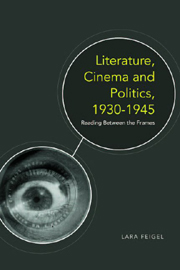Book contents
- Frontmatter
- Contents
- Acknowledgements
- List of Figures
- Introduction
- 1 Radical Cinema
- 2 Mass Observing: The 1930s Documentary Gaze
- 3 The Documentary Movement and Mass Leisure, 1930–1945
- 4 Camera Consciousness
- 5 Framing History: Virginia Woolf and the Politicisation of Aesthetics
- 6 ‘The savage and austere light of a burning world’: The Cinematic Blitz
- Afterword
- Endnotes
- Bibliography
- Index
5 - Framing History: Virginia Woolf and the Politicisation of Aesthetics
Published online by Cambridge University Press: 12 September 2012
- Frontmatter
- Contents
- Acknowledgements
- List of Figures
- Introduction
- 1 Radical Cinema
- 2 Mass Observing: The 1930s Documentary Gaze
- 3 The Documentary Movement and Mass Leisure, 1930–1945
- 4 Camera Consciousness
- 5 Framing History: Virginia Woolf and the Politicisation of Aesthetics
- 6 ‘The savage and austere light of a burning world’: The Cinematic Blitz
- Afterword
- Endnotes
- Bibliography
- Index
Summary
In Three Guineas (1938), Virginia Woolf attempts to reclaim Spanish Civil War photography from the realm of the hyperreal. Woolf goes against Spender's understanding of the war in Spain as a second-hand experience, where photographs of atrocities lose their power to shock through familiarity. Instead, she uses the photographs that the ‘Spanish Government sends with patient pertinacity about twice a week’ to create a consensus of ‘horror and disgust’ in her audience as she wages a feminist war against war (p. 125).
She does this, in the first instance, by incorporating the images in her text through descriptions rather than reproductions. Elena Gualtieri has argued that the pictures Woolf refers to are the same photographs of hideously maimed children printed in the Daily Worker, accompanied by an explanation justifying their inclusion. If Gualtieri is right, in choosing not to follow the Daily Worker, Woolf seems to trust language to do a better job than the images themselves. According to Maggie Humm, the descriptions do not correspond to any of the photographs collected in the Marx library, and may well be imaginary. They are linguistic portraits, and through language Woolf can admit the ambiguity of the represented reality at the same time as she insists on the power of its effect:
They are not pleasant photographs to look upon. They are photographs of dead bodies for the most part. This morning's collection contains the photographs of what might be a man's body, or a woman's; it is so mutilated that it might, on the other hand, be the body of a pig. But those certainly are dead children.
- Type
- Chapter
- Information
- Literature Cinema and Politics 1930–1945Reading Between the Frames, pp. 155 - 192Publisher: Edinburgh University PressPrint publication year: 2010



